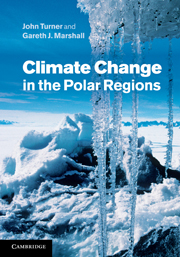Book contents
7 - Predictions for the next 100 years
Published online by Cambridge University Press: 07 September 2011
Summary
Introduction
Many of the high latitude climatic changes discussed in earlier chapters occurred because of natural climate variability, associated with fluctuations in the orbit of the Earth around the Sun, changes in the amount of solar radiation emitted by the Sun, volcanic eruptions that injected large amounts of dust into the atmosphere, changes in the ocean circulation and exchanges of heat between the ocean and atmosphere. However, from about the middle of the eighteenth century, at the start of the Industrial Revolution, humankind began to influence the climate system through the emission of increasing amounts of greenhouse gases. At first the impact was very small, but in the last decade of the nineteenth century Svante Arrhenius (Arrhenius, 1896) suggested that the increasing blanket of greenhouse gases above the Earth could raise temperatures in the troposphere. However, it was only in the second half of the twentieth century that there was widespread interest in climate change as decade on decade the mean temperature of the Earth started to increase and record high temperatures were registered with increasing frequency.
The occurrence in recent decades of high profile severe weather events, such as droughts, severe hurricanes and heat waves, resulted in major debates on the role of humans in these events. In the early years of the twenty-first century it was hard to open a newspaper or switch on a television without encountering discussions on the reasons for recent climate change, with environmentalists and global warming ‘sceptics’ presenting opposing views.
- Type
- Chapter
- Information
- Climate Change in the Polar Regions , pp. 336 - 373Publisher: Cambridge University PressPrint publication year: 2011



